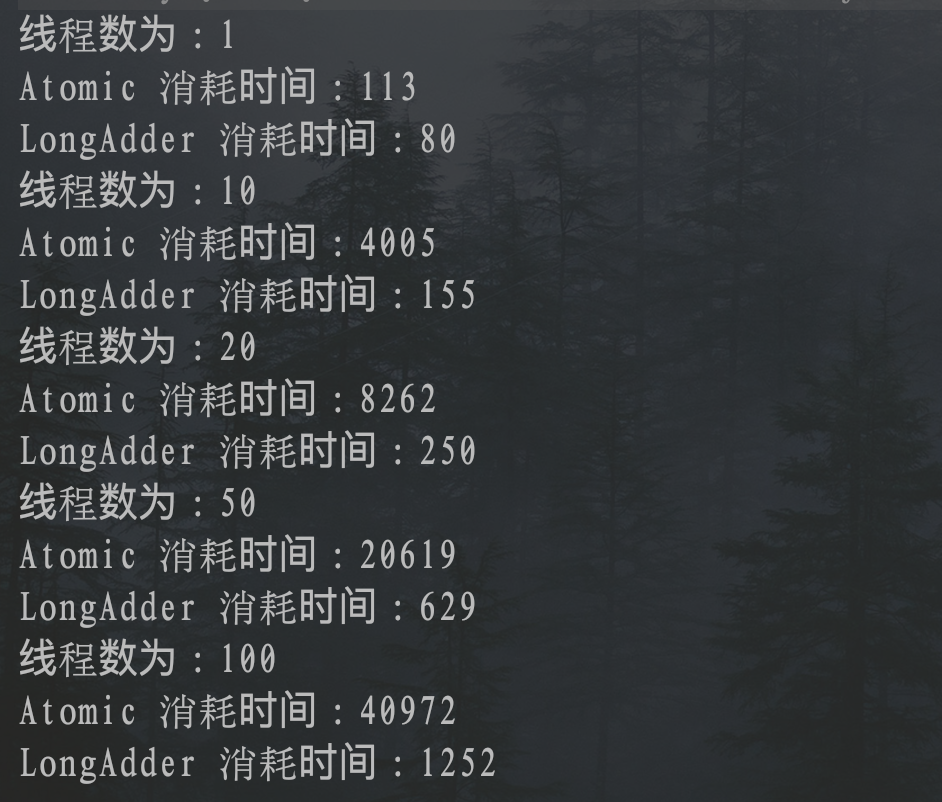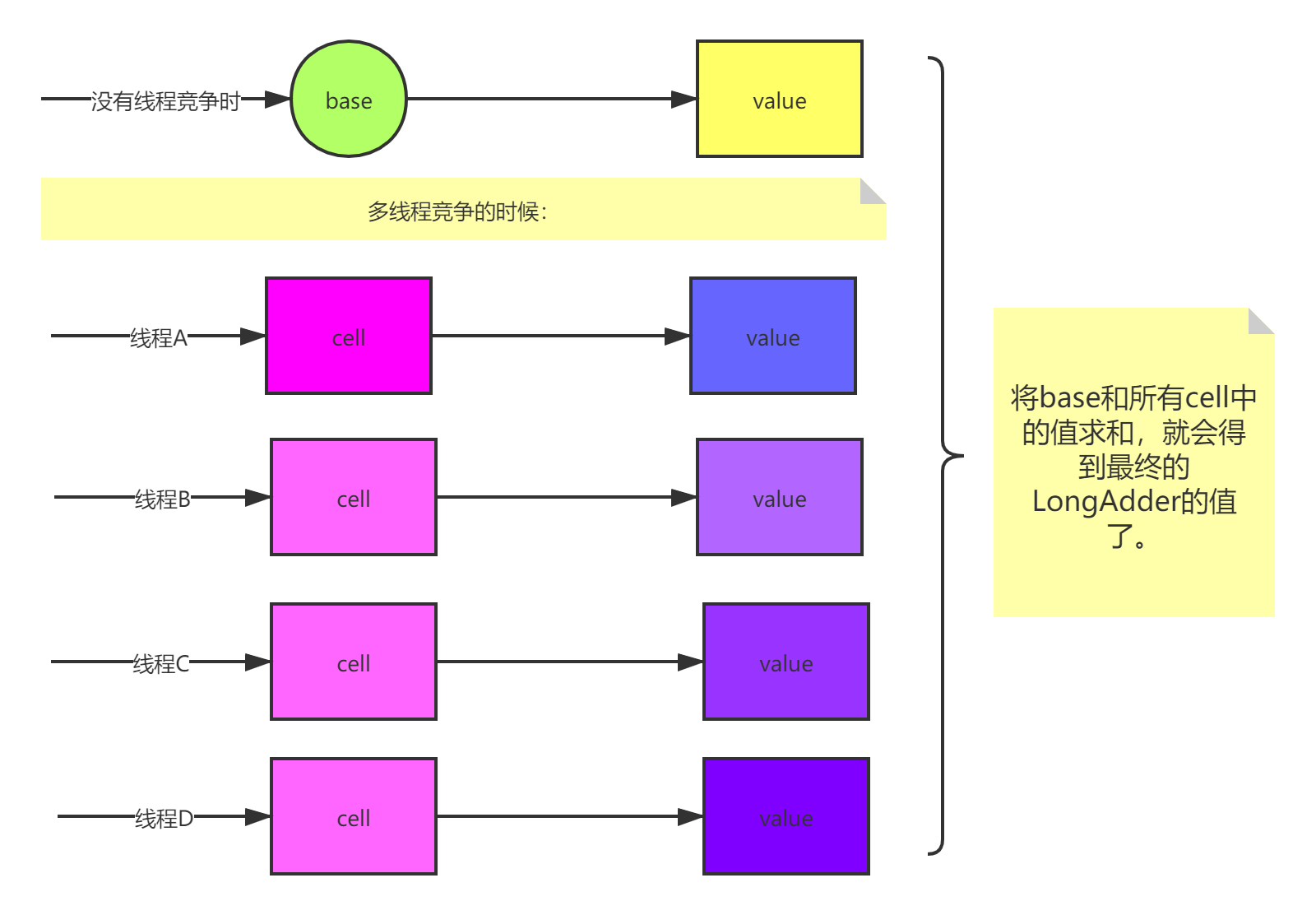一,为什么要用LongAdder

【参考】volatile 解决多线程内存不可见问题。对于一写多读,是可以解决变量同步问题,但是如果多写,同样无法解决线程安全问题。
说明:如果是 count++ 操作,使用如下类实现:AtomicInteger count = new AtomicInteger(); count.addAndGet(1); 如果是 JDK8,推荐使用 LongAdder 对象,比 AtomicLong 性能更好(减少乐观 锁的重试次数)。
以上内容来自阿里《Java开发手册》。
里面提到了多线程读写环境下,LongAdder相对于Atomic原子类拥有更好的效率。
public class LongAdderAndAtomicTest {private static AtomicInteger a = new AtomicInteger(0);private static LongAdder b = new LongAdder();public static void main(String[] args) throws Exception {test(1, 10000000);test(10, 10000000);test(20, 10000000);test(50, 10000000);test(100, 10000000);}/*** 测试LongAdder和Atomic的效率** @param threadNum 线程数* @param times 执行时间*/public static void test(Integer threadNum, Integer times) throws Exception {System.out.println("线程数为:" + threadNum);testAtomic(threadNum, times);testLongAdder(threadNum, times);}/*** 测试Atomic的效率** @param threadNum* @param times*/public static void testAtomic(Integer threadNum, Integer times) throws InterruptedException {//开始时间long start = System.currentTimeMillis();CountDownLatch countDownLatch = new CountDownLatch(threadNum);for (int i = 0; i < threadNum; i++) {new Thread(() -> {for (int j = 0; j < times; j++) {a.incrementAndGet();}countDownLatch.countDown();}).start();}countDownLatch.await();//结束时间long end = System.currentTimeMillis();System.out.println("Atomic 消耗时间:" + (end - start));}/*** 测试LongAdder的效率** @param threadNum* @param times*/public static void testLongAdder(Integer threadNum, Integer times) throws InterruptedException {//开始时间long start = System.currentTimeMillis();CountDownLatch countDownLatch = new CountDownLatch(threadNum);for (int i = 0; i < threadNum; i++) {new Thread(() -> {for (int j = 0; j < times; j++) {b.increment();}countDownLatch.countDown();}).start();}countDownLatch.await();//结束时间long end = System.currentTimeMillis();System.out.println("LongAdder 消耗时间:" + (end - start));}}

由图可以看到,线程数越多,LongAdder的效率型对于Atomic越高,由此可以看出,LongAdder更适合于高并发情况下。
二,LongAdder源码阅读
看LongAdder类的继承关系:
public class LongAdder extends Striped64 implements Serializable
LongAdder这个类继承自Striped64,Striped64里面声明了一个内部类Cell。
@sun.misc.Contended static final class Cell {//拥有内存可见性的valuevolatile long value;//带参数的构造器Cell(long x) { value = x; }//调用unsafe类的cas对cmp和bal进行比较交换,返回是否成功final boolean cas(long cmp, long val) {return UNSAFE.compareAndSwapLong(this, valueOffset, cmp, val);}//声明unsafe类private static final sun.misc.Unsafe UNSAFE;//声明cell成员属性的内存偏移量private static final long valueOffset;//初始化static {try {UNSAFE = sun.misc.Unsafe.getUnsafe();Class<?> ak = Cell.class;valueOffset = UNSAFE.objectFieldOffset(ak.getDeclaredField("value"));} catch (Exception e) {throw new Error(e);}}}
//获取当前系统的cpu数 控制cells数组长度的一个关键条件static final int NCPU = Runtime.getRuntime().availableProcessors();//数组的长度,只要数组不为空,一定是2的倍数,这样-1转化为二进制的时候一定是一大堆1transient volatile Cell[] cells;//没有发生过竞争时,数据会累加到 base上 | 当cells扩容时,需要将数据写到base中transient volatile long base;//初始化cells或者扩容cells都需要获取锁,0 表示无锁状态,1 表示其他线程已经持有锁了transient volatile int cellsBusy;
LongAdder里面使用的这两个属性实际上是继承自他的父类的。
public void add(long x) {/*** as: 表示cells数组的引用* b: 表示获取的base值* v: 表示期望值* m: 表示cells数组的长度* a: 表示当前线程命中的cell单元格*/Cell[] as; long b, v; int m; Cell a;/*** 条件一:true->表示cells已经初始化过,当前线程应该将数据写入到对应的cell中* false->表示cells未初始化,当前所有线程应该将数据写入到base中* 条件二:false->表示当前线程cas替换数据成功* true->表示发生竞争了,可能需要重试或者扩容* 进入if的条件:数组已经初始化 或者 cas交换数据失败,表示有竞争**/if ((as = cells) != null || !casBase(b = base, b + x)) {/*** uncontended: true -> 未竞争 false->发生竞争* 条件一:true->数组没有初始化* false->数组已经初始化* 条件二:true->数组没有初始化* false->数组已经初始化** getProbe():获取当前线程的hash值* 条件三:true-> 当前线程对应的cell并没有初始化* false->当前线程对应的cell已经初始化* 条件四:true->cas交换失败,表示有竞争* false->cas交换成功* 进入if的条件:* cells未初始化, 或者 当前线程对应的cell未初始化, 或者 cas交换失败*/boolean uncontended = true;if (as == null || (m = as.length - 1) < 0 ||(a = as[getProbe() & m]) == null ||!(uncontended = a.cas(v = a.value, v + x)))longAccumulate(x, null, uncontended);}}
接下来看longAccumulate()。
/*** 首先:哪些情况会进入当前方法?* cells未初始化, 或者 当前线程对应的cell未初始化, 或者 cas交换失败* @param x 新值* @param fn 没用上。一个扩展接口* @param wasUncontended 只有cells初始化之后,并且当前线程 竞争修改失败,才会是false*/final void longAccumulate(long x, LongBinaryOperator fn,boolean wasUncontended) {//h:代表当前线程hash值int h;/*** 如果当前线程hash值等于0,条件成立* 给当前线程分配hash值* 将当前线程的hash值重新赋值给h* 设置为未竞争或者竞争修改成功状态。* 为什么?* 因为默认所有线程进来操做的都是cells[0]的位置,所以不把它当作一次真正的竞争。*/if ((h = getProbe()) == 0) {//给当前线程分配hash值ThreadLocalRandom.current(); // force initialization//将当前线程的hash值重新赋值给hh = getProbe();wasUncontended = true;}//表示扩容意向 false 一定不会扩容,true 可能会扩容。boolean collide = false;//自旋for (;;) {/*** as 代表cells的引用* a 当前线程对应的cell* n cells的长度* v 期望值*/Cell[] as; Cell a; int n; long v;/*** case1:* cells已经初始化** case1.1:* if(当前线程对应的cell还没有初始化 && 当前处于无锁状态){* 创建一个新的cell对象 r** if(当前锁状态未0并且获取到了锁){* created : 标记是否创建成功* if(cells已经被初始化 && 当前线程对应的cell为空){* 将当前线程对应位置的cell初始化为新创建的cell r* create=true 表示创建成功,最终在释放锁。* }* }* 将扩容意向改成false* }** case1.2:* if(如果当前线程竞争修改失败){* 状态改为true;* //默认所有线程一开始都在cell[0]的位置,所以一定会发生竞争,* //这次竞争就不当作一次真正的竞争。* }** case1.3:* if(当前线程rehash过hash值 && 新命中的cell不为空){* 尝试cas一次* }** case1.4:* if(如果cells的长度>cpu数 || cells和as不一致){* //cells和as不一致 说明其他线程已经扩容过了,当前线程只需要rehash重试即可* 扩容意向强制改为false。* }** case1.5:* //!collide = true 设置扩容意向 为true 但是不一定真的发生扩容** case1.6:* if(锁状态为0 && 获取到了锁){* //第二层判断为了防止当前线程在对第一层id的条件判断一半的时候,又进来一个线程,将所有业务已经执行一遍了。* //只有当cells==as才能说明,当前线程在第一层if执行条件的过程中,没有其他线程进来破坏。* if(cells==as){* 扩容为原来的二倍* 重置当前线程Hash值* }* }*/if ((as = cells) != null && (n = as.length) > 0) {if ((a = as[(n - 1) & h]) == null) {if (cellsBusy == 0) { // Try to attach new CellCell r = new Cell(x); // Optimistically createif (cellsBusy == 0 && casCellsBusy()) {//标记是否创建成功boolean created = false;try {/*** rs:cells的引用* m:cells的长度* j:当前线程对应的cells下标*/Cell[] rs; int m, j;if ((rs = cells) != null &&(m = rs.length) > 0 &&rs[j = (m - 1) & h] == null) {rs[j] = r;created = true;}} finally {cellsBusy = 0;}if (created)break;continue; // Slot is now non-empty}}collide = false;}else if (!wasUncontended) // CAS already known to failwasUncontended = true; // Continue after rehashelse if (a.cas(v = a.value, ((fn == null) ? v + x :fn.applyAsLong(v, x))))break;else if (n >= NCPU || cells != as)collide = false; // At max size or staleelse if (!collide)collide = true;else if (cellsBusy == 0 && casCellsBusy()) {try {if (cells == as) { // Expand table unless staleCell[] rs = new Cell[n << 1];for (int i = 0; i < n; ++i)rs[i] = as[i];cells = rs;}} finally {cellsBusy = 0;}collide = false;continue; // Retry with expanded table}//重置当前线程Hash值h = advanceProbe(h);}/*** case2:* cells并未初始化* 锁状态为0* cells==as ? 因为其它线程可能会在你给as赋值之后修改了 cells* 获取锁成功* 里面再次判断cells==as是因为防止其他线程在判断第一层if的中间被其他线程先进来修改了一次* 初始化cells*/else if (cellsBusy == 0 && cells == as && casCellsBusy()) {boolean init = false;try { // Initialize tableif (cells == as) {Cell[] rs = new Cell[2];rs[h & 1] = new Cell(x);cells = rs;init = true;}} finally {cellsBusy = 0;}if (init)break;}/*** case3:* cellsBusy处于加锁状态,表示其他线程正在初始化cells,* 那么当前线程就应该将数据累加到base*/else if (casBase(v = base, ((fn == null) ? v + x :fn.applyAsLong(v, x))))break; // Fall back on using base}}
getProbe()获取当前线程hash值。
static final int getProbe() {return UNSAFE.getInt(Thread.currentThread(), PROBE);}
casCellsBusy()cas的方式获取锁。
final boolean casCellsBusy() {return UNSAFE.compareAndSwapInt(this, CELLSBUSY, 0, 1);}
advanceProbe(h)重置当前线程hash值。
static final int advanceProbe(int probe) {probe ^= probe << 13; // xorshiftprobe ^= probe >>> 17;probe ^= probe << 5;UNSAFE.putInt(Thread.currentThread(), PROBE, probe);return probe;}
casBase()cas的方式改变base值。
final boolean casBase(long cmp, long val) {return UNSAFE.compareAndSwapLong(this, BASE, cmp, val);}
三,LongAdder执行流程
LongAdder的执行流程实际上就是:
- 当没有线程竞争的时候,线程会直接操做base里面的值。
- 当有线程竞争的时候,会将base的值拷贝成一个cells数组,每个线程都来操作一个cell数组中的桶位,最终将cells各个桶位和base求和,就可以得到LongAdder的最终值。

public void add(long x) {if(数组未初始化||cas的方式把值写入base失败){if(数组未初始化||当前线程对应的单元格未初始化||或cas的方式在当前线程对应的单元格交换数据失败,说明有竞争){longAccumulate(x, null, uncontended);}}}final void longAccumulate(long x, LongBinaryOperator fn,boolean wasUncontended) {if(当前线程hash值==0){重置当前线程hash值是否发生竞争改为true}声明扩容意向=falsefor(;;){if(数组已经初始化过){if(当前线程命中的单元格未初始化){if(如果当前数组不是正在扩容){创建一个新的Cell(x)if(当前并未有其他线程对数组进行扩容&&且当前线程竞争扩容数组的权利成功){声明 创建完成 =false;if(数组不为空&&当前没有线程正在操作数组&&且当前线程命中的单元格为空){将当前线程对应的单元格初始化为刚才创建的cell创建完成 =true;释放 数组扩容的权利}if(数组已经创建完成){break}continue;}}扩容意向 =false}else if(如果当前线程竞争修改失败){状态设置为true//默认所有线程1开始都在cell[0]的位置,所以一定会发生竞争,这次竞争就不当做一次真正的竞争}else if(cas的方式修改当前线程命中的单元格成功){break}else if(数组长度大于cpu数||cells长度 和当前数组长度不一致){扩容意向 =false//cells长度 和当前数组长度不一致:说明已经有其他线程扩容了,当前线程只要rehash重试即可。}else if(扩容意向==false){扩容意向 = true //但是不一定真的发生扩容}else if(当前没有线程正在在扩容数组 && 并且当前线程竞争到了扩容数组的资格){if(在这个过程中没有线程把数组扩容了,也就是啥也没发生){数组扩容一倍,将原数组的值进行一个拷贝,将新数组的地址指向原数组}释放数组扩容的权利扩容意向改成false}把当前线程的hash值rehash}//当前数组没有被初始化else if(当前没有线程正在初始化数组,也没有线程已经初始化完了,并且当前线程竞争到了初始化的权利){声明 初始化 == falseif(当前数组还未初始化,说明没有线程已经初始化完了){创建一个长度为2 的数组并把当前线程命中的单元格初始化初始化 == true}释放数组扩容权利if(初始化==true){break}}//如果有线程正在初始化数组,那么当前线程就应该将数据累加到baseelse if(cas的方式修改base值成功){break}}}
1.为什么比cas的效率高?
- cas是多线程竞争,只有拿到锁的线程才能去操做资源,其他线程不断的自旋重试,相当于线程排队。
- LongAdder是多线程竞争的时候,他会将共享资源拷贝多份,采用分支合并的思想,提升效率。

